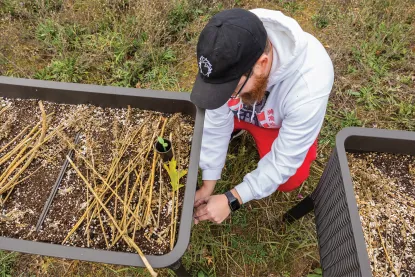By Kristi Evans
Northern Michigan University researchers are exploring the feasibility of using hemp to remediate soil contaminated with PFAS, a group of manufactured chemicals that make a wide range of industry and consumer products non-stick, greaseproof and flame retardant. Though the chemicals have been used since the 1940s, there is escalating concern because many break down slowly and can accumulate in people, animals and the environment over time, causing significant health risks, according to the Environmental Protection Agency.
NMU Chemistry Professor Lesley Putman (pictured with medicinal plant chemistry major Dustin Goodman) said the hope is that hemp will not only draw up PFAS from the ground, but ultimately be able to degrade them, unlike the typical and more costly remediation methods using granular activated charcoal or reverse osmosis.
Putman said PFAS tend to be lumped together into one group, even though not all are toxic and the molecules vary in size. She and three students in her lab first experimented with a small type that is not considered toxic, perfluorobutanoic acid (PFBA).
“We grew industrial hemp hydroponically and added PFBA to the water in which the plants were growing,” Putman said. “The hemp took it up into the leaves, stems and flowers, and it didn’t affect the growth of the plant. We got the same result in a greenhouse, planting the seedlings in soil and applying water containing PFBA. Then we did the same experiments with the two main toxic chemicals: PFOS and PFOA. Because those are larger molecules that don’t move as easily and aren’t as water- soluble as small ones, they didn’t go up into the leaves as readily and were sequestered in the roots. But nevertheless, if hemp can hold them up, that’s a good starting point.”
Putman did not have to search far to find practical applications for the research. Wastewater from the sewage treatment plant at the former KI Sawyer Air Force Base had tested positive for PFOS. The same substance was reported at a base in Maine, where a group grew hemp to remediate contamination by firefighting foam. Putman attended a day-long information session at Sawyer, and also picked up two buckets of sludge from there to bring back to her lab.
Even if hemp proves equally or more effective than activated charcoal in preventing PFAS from permeating the water table, “you’re still left with plants that contain toxins,” Putman said.
Recognizing that enzymes produced by mushrooms can effectively break down different pollutants in soil—a process called mycoremediation—Putman is in conversations with Myconaut, a Marquette business co-founded by NMU alumnus Joe Lane '19 BS that explores the varied potential of fungi. “Maybe we could inoculate some of the hemp roots with a fungus and see if that helps to degrade the PFAS,” she said.
If hemp becomes more established for phytoremediation, researchers will breed a variety that optimizes that function.
“I feel extremely fortunate that, as an undergrad, I get to do this kind of research with practical implications,” said medical plant chemistry major Asbel Wells.

“I like the idea of working with PFAS, especially at this time because it’s a compound that people are really starting to pay more attention to in the environment,” said student Kevin Schick. “It’s cool to be on the forefront of this type of research and see how we can get it out of the environment.”
